How to insulate the wall in the apartment from the inside: the best technology + workflow
One of the most important living conditions in an apartment is a good heat supply, for which either a centralized heating system or autonomous equipment installed by residents is responsible. However, the heating efficiency directly depends on the correctly performed thermal insulation of the premises.
Consider how to insulate a wall in an apartment to increase air temperature and at the same time reduce energy costs for heating. For this, we give two detailed instructions on thermal insulation with popular types of insulation, in which each step is illustrated with photographs.
Also in this material we will consider less popular methods that can be used to insulate walls from the inside.
The content of the article:
When is it necessary to warm the apartment?
The predominant way of warming the walls of apartments and houses is still external thermal insulationthat does not affect the dew point shift and heats the entire wall.
If the insulation layer is mounted on the inside, the wall freezes over the entire thickness, andDew point moves closer to the living room.

However, the external method is not always suitable. There are difficulties with the installation of insulation on panel high-rises, as well as on walls adjacent to technical spaces, for example, an elevator shaft. If the building is a historical object, the appearance of the facade cannot be changed.
However, in some cases, you just can not do without thermal insulation:
Without wall insulation, the efficiency of heating devices is reduced. Frozen walls, cold bridges, dampness create unsanitary conditions and become the root cause of diseases.
However, you can protect yourself from cold and illness by warming one or more walls in the apartment from the inside using one of the methods listed below.
Best Ways and Detailed Instructions
The technologies that builders use to insulate walls depend on several factors: installation conditions, the necessary degree of protection, and the choice of material. The best options are recognized combinations of modern thermal insulation materials and decorative finishes with an additional function of insulation.
Option # 1 - EPSP on the crate + drywall
Extruded polystyrene foam (EPS) is considered one of the most effective insulation if it is necessary to carry out the process of thermal insulation of a room or the entire apartment from the inside.
It is sold in the form of rigid boards, consisting of several components: polystyrene granules, a gas mixture and a blowing agent.
The main advantages of extruded polystyrene foam:
- small thickness of the plates, allowing you to save the usable area of the premises;
- minimal water absorption;
- resistance to temperature extremes;
- light weight;
- simple processing.
This is a material that can be purchased and cut into fragments convenient for installation. But there is also a minus - low vapor permeability. In an apartment with thermal insulation, it is necessary to equip good ventilation.
More on the pros and cons of extruded polystyrene foam we wrote here.
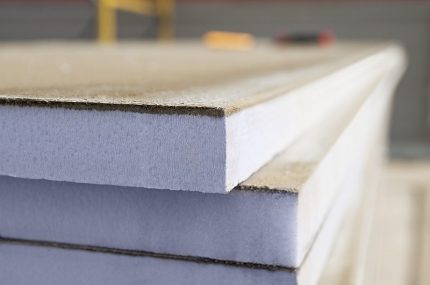
As a heat-insulating material, we take an EPPS with a thickness of 50 mm, and for the construction of the frame (crate) - a wooden beam of 50 * 50 mm and 50 * 30 mm with markings for holes. As fasteners we use dowels in plastic and self-tapping screws. You will also need a vapor barrier membrane, adhesive tape for vapor barrier.
Minimum Toolkit:
- marker and ruler for marking;
- a special hacksaw for cutting EPS plates into pieces of the required size;
- drill with drills for dowels;
- construction stapler.
The hacksaw for a heater is ground so that when cutting material it does not dust. It is also suitable for mineral wool, glass wool, ordinary polystyrene foam.
Thermal insulation instructions:
If you neglect the installation of a vapor barrier, the thermal insulation materials will get wet from the condensate that will appear in any case.
As a result, mold will appear, and the effect of thermal insulation will noticeably decrease. If you find mold on the walls of your home, we recommend that you read the best antiseptics against her.
A wall lined with drywall is ready for finishing: puttying, painting or wallpapering.
Instead of conventional plates of extruded polystyrene foam with a glossy surface, an alternative material is increasingly being used - EPS with a rough top layer and grooves that increase the degree of adhesion.
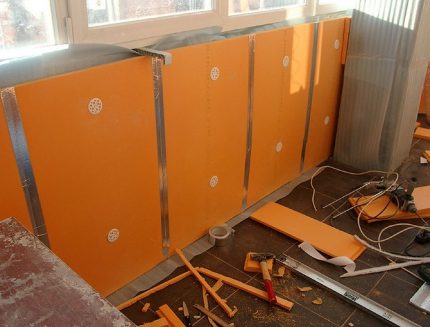
Fixed plates are treated with a base reinforcing compound, and then paint is applied in 2-3 layers or wallpaper is glued. “Fur coat” made of EPSP is able to raise the room temperature by 4-5 °, which will certainly affect the saving of resources for heating.
Option # 2 - ISOVER mineral wool + OSB boards
The second technology solution is similar to the first, although completely different materials are used for installation. The thermal insulation layer will consist of mineral wool, and OSB boards will form the basis for the finish.

ISOVER products are certified, approved for use even in children's and medical institutions. It has a thermal conductivity of 0.038 W / (m · K) and a flammability group of NG - both indicators for GOST R 31924 and 30244-94.
Advantages of mineral wool:
- it retains heat well, has a low coefficient of thermal conductivity;
- environmentally and fireproof;
- It is produced by plates, convenient for installation;
- eliminates moisture accumulation;
- light weight.
But there are also disadvantages: some types of mineral wool in the composition have components that emit phenol, and manipulations with the material necessarily require compliance with TB - the presence of overalls and masks (glasses).
Oriented particle boards (OSB) are laid on top of mineral wool on a crate of wooden blocks or metal rails. This is a material made from wood chips, resins and polymer adhesive.
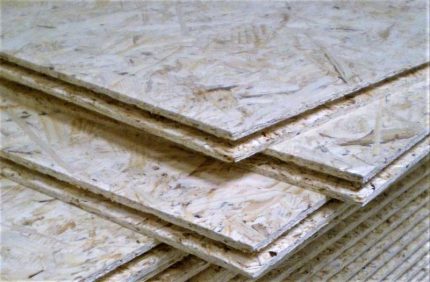
Due to the wood composition, the panels are fire hazard (class G4), therefore, before or after installation, they are covered with protective flame retardants - flame retardants.
Assembly instruction:
If the walls are even and the material is prepared in advance, it is possible to insulate a room of 20 m² in 5-6 hours, working alone.
But this is facilitated by ISOVER products: mineral wool is easy to cut and stack, and vapor barrier sheets do not even require construction adhesive tape for gluing, since they are initially equipped with an integrated mounting tape.
A prerequisite for basalt wool insulation is the installation of forced ventilation. The device is mounted in the duct, and fresh air provides regular manual ventilation or special valves on the windows.
If a partition is planned to be built in the insulated room, then it can also be done with mineral wool, but it is better to replace OSB boards with sheets of drywall.
Isover is placed between two walls of LGA, with each wall made of 2 layers of drywall. Such a partition will protect against cold and noise no worse than a full-fledged reinforced concrete wall.
Both of the presented methods have disadvantages that must be considered when planning work.
Firstly, they select part of the usable area and reduce the space of the living quarters along the perimeter, secondly, they require significant investments in the family budget, and thirdly, when applying them, all the nuances of the technology must be observed.
A brief overview of other ways
Other technologies are also used, among which are found both obsolete, but cheaper, and modern, requiring considerable investments.
Installation of expanded polystyrene or polystyrene
With the advent of EPSS, the use of conventional stress-free polystyrene foam (PSB) has become impractical, since it has degraded performance.
Namely:
- burns and meltsby releasing hazardous substances;
- fragiledue to which the pieces break under mechanical pressure;
- not protected from rodents.
In terms of parameters, it is inferior to extruded polystyrene foam, and this can be seen in the table of physical and technical properties of expanded polystyrene plates:
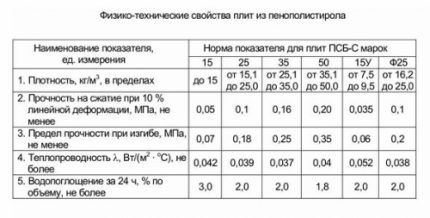
However, light and thick plates are still used when it is necessary to quickly and inexpensively warm the room. We recommend using this material for facing garages and utility rooms, that is, non-residential premises.
Liquid-ceramic insulation spraying
To provide a “cold” wall with additional thermal insulation, substances are also applied that are applied according to the principle of painting, that is, using a special spray gun, spray gun or brush. We talked more about the methods of warming the cold walls of an apartment in this article.
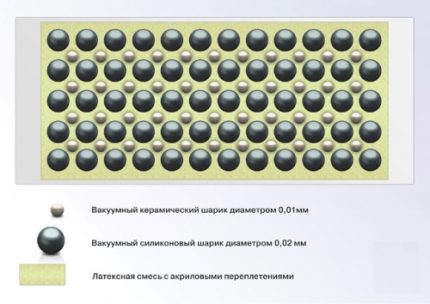
Advantages of liquid ceramic spraying:
- moisture resistance;
- mechanical stability;
- elasticity;
- ease of application;
- environmental friendliness;
- minimum load on the structure.
The main advantage is the thinness of the applied layer while maintaining important thermal insulation characteristics.
In terms of efficiency, a 1-mm layer of ZhKN is equal to a slab of basalt wool 50 mm thick and is able to increase the temperature in the room by 3-4 degrees. Builders love sprayer for its ease and high speed of application.
After applying the liquid-ceramic mixture, additional waterproofing and vapor barrier are not needed. A thin layer withstands temperatures from -60 ° C to +250 ° C, and serves, subject to application technology, up to 30 years.
Cork and polystyrene wallpapers
Of course, sticking with one layer cannot be compared with a full-fledged heat-holding “cake”, however wallpapers are actively used both in corner apartments and on the ground floor rooms.
Polystyrene foam wallpaper resembles ordinary non-woven, have a thickness of 0.3-1.0 mm, are sold in 10-meter rolls, are glued on the same principle - butt. However, special glue is intended for them.
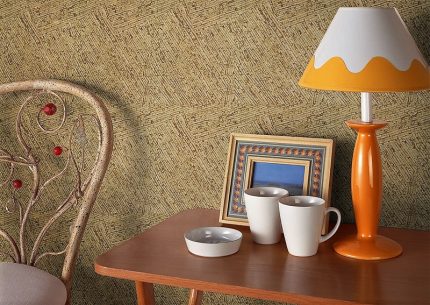
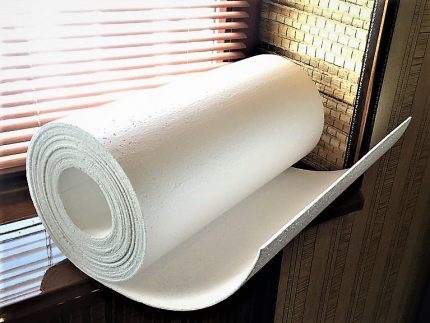
Disadvantages of the material: like PPP boards, wallpaper shifts the dew point closer to the living room and refers to a combustible finish, like paper wallpaper.
In addition to these materials, eco-friendly and glass wool, wood chipboards, arbolite, foamed polyvinyl chloride and polyethylene insulation, fiberboard, honeycomb panels, reflective thermal insulation with a foil layer are used — materials such as Penofol or Armofol.
Each of the listed heaters has the right to life and, under suitable conditions, perfectly performs its functions. In more detail, all the popular types of insulation that can be used for walls of the house from the inside, their pros and cons and characteristics, we examined in our other article.
When choosing a material, you need to focus on the technical properties, cost and complexity of installation - sometimes the installation technique for untrained amateurs causes difficulties.
Conclusions and useful video on the topic
Recommendations for choosing a heater:
Expert advice on choosing the appropriate type of insulation:
The method for an uninsulated house or apartment:
When choosing a thermal insulation technology, it is important to consider the installation conditions. For example, for small rooms, installation on a crate is not suitable, since it steals part of valuable space, but for large rooms this is an ideal option, the most effective of all available.
A great advantage of all the above methods of insulation - they can be done independently, and some even without special preparation.
Choose the best way of insulation for the walls of your apartment and you have any questions? Ask them below under this article - our experts and other site visitors will try to help you.
If you have already managed to insulate the walls of the apartment, please share your experience with beginners. Tell us what material you preferred and whether the result matches your expectations.

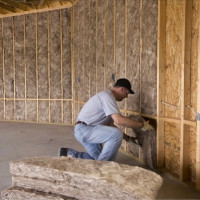 How to insulate a cold apartment from the inside: suitable materials + installation instructions
How to insulate a cold apartment from the inside: suitable materials + installation instructions 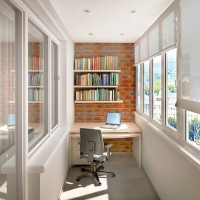 How to insulate a loggia: options + instructions for installing a do-it-yourself warming system from the inside
How to insulate a loggia: options + instructions for installing a do-it-yourself warming system from the inside 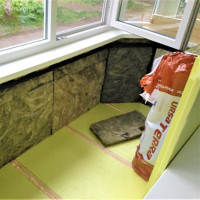 Do-it-yourself warming the balcony: popular options and technologies for warming the balcony from the inside
Do-it-yourself warming the balcony: popular options and technologies for warming the balcony from the inside 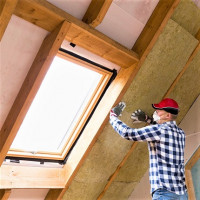 The better to insulate the attic: the best thermal insulation materials for arranging the attic roof
The better to insulate the attic: the best thermal insulation materials for arranging the attic roof 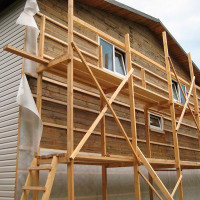 How to sheathe a wooden house outside: the best types of materials and technologies for their installation
How to sheathe a wooden house outside: the best types of materials and technologies for their installation 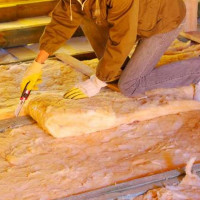 Floor insulation in a wooden house: work procedure + popular heaters
Floor insulation in a wooden house: work procedure + popular heaters  How much does it cost to connect gas to a private house: the price of organizing gas supply
How much does it cost to connect gas to a private house: the price of organizing gas supply  The best washing machines with dryer: model rating and customer tips
The best washing machines with dryer: model rating and customer tips  What is the color temperature of light and the nuances of choosing the temperature of the lamps to suit your needs
What is the color temperature of light and the nuances of choosing the temperature of the lamps to suit your needs  Replacement of a geyser in an apartment: replacement paperwork + basic norms and requirements
Replacement of a geyser in an apartment: replacement paperwork + basic norms and requirements
One of the rooms in the apartment froze in us, a very unpleasant situation. Corner room, which was planned for the nursery. I had to insulate from the inside. Yes, the internal area has decreased, but what to do? Themselves did not dare to warm, called the master. He made extruded polystyrene foam, it turned out very well. Wonderful material for internal insulation. But it is not suitable for a wet facade, they were personally convinced when he did not last a year at the dacha.
I don’t know what kind of master you had, which insulated the facade of the house with extruded polystyrene foam and, as a result, it began to fall off. Or did you do insulation yourself? Then only you are to blame!
The fact is that it is just customary to perform external wall insulation with extruded polystyrene foam. Yes, you can use it indoors, but the loss of usable area is not the main drawback. The material becomes toxic when heated above 80 * C, so not many people risk using it as an internal insulation.
And now the salt itself, as they say - extruded polystyrene foam is not afraid of water! Even if you completely immerse the plate in water for a day, the polystyrene humidity rises by only 0.2%, like this. This means that this insulation is not threatened by deformation and fungi with high humidity.
At your dacha, this material did not hold out for you for a completely different reason. Perhaps there were errors during installation or the wrong adhesive or fasteners were used.
When we finished, the room used plates of foam and chipboard. In principle, one could take OSBs, but they are expensive and not very different from particleboards. Only now if you use chipboards, you will have to tinker. Wallpaper on them without impregnation is bad to hold. It was possible to buy it, but we solved the problem this way: we bought PVA glue, mixed with clean water in the proportion of 1/4 and applied in three layers with intermediate drying. Everything dried up pretty quickly, but the consumption was decent: it took only two buckets. We applied this impregnation with a roller, with a brush it flies a lot around. The result was good: warm and very comfortable!
We, like many, were faced with the problem of temperature differences in the apartment during the winter period. If adults could still adapt to such conditions, then children were susceptible to colds. It was simply not enough to do without additional warming. After consulting with specialists, we decided to choose polyurethane foam.The main advantage of this material is that it does not leave cavities for the accumulation of condensate. All work in the apartment was done efficiently, therefore, a positive result was not long in coming.